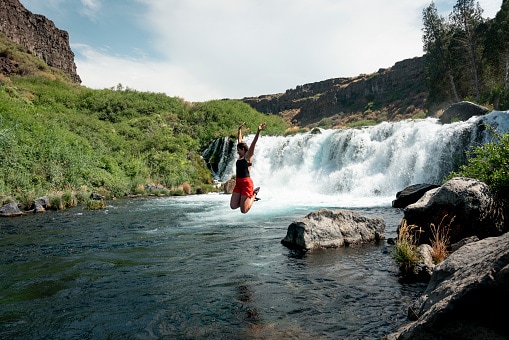Idaho is known for its stunning landscapes, outdoor recreational opportunities, and vibrant communities. It is also one of the largest states in the United States. Its vast expanse of land encompasses diverse terrain, including mountains, valleys, and plains.
How Many Acres Is Idaho?
We can quantify the state’s size in acres to understand its vastness.
| Measurement | Value |
|---|---|
| Acres | 52,796,960 acres |
Idaho spans an impressive 52,796,960 acres, making it a substantial state with an abundance of natural beauty and resources.
How Many Square Miles (and Kilometers) Is Idaho?
Another way to quantify the state’s size is by calculating its area in square miles and square kilometers.
| Measurement | Value |
|---|---|
| Square Miles | 83,569 square miles |
| Square Kilometers | 216,443 square kilometers |
Idaho covers approximately 83,570 square miles or 216,443 square kilometers. This extensive area includes a wide range of landscapes, from the majestic Rocky Mountains to fertile agricultural plains.
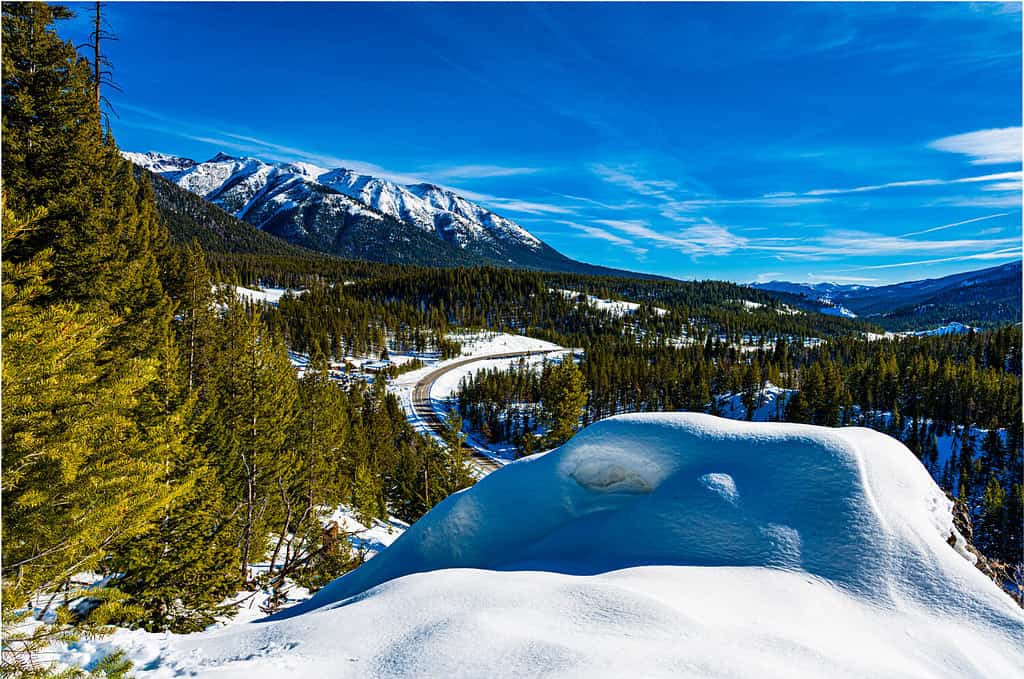
Idaho is one of the largest states in the country, with diverse landscapes from mountains to valleys and fertile plains.
©Karl Eggleston/Shutterstock.com
How Big Is Idaho Compared to Other States?
Let us examine how the state measures up against some of its neighboring states.
Idaho vs. Texas
| Measurement | Idaho | Texas |
|---|---|---|
| Acres | 52,796,960 | 168,581,629 |
| Square Miles | 83,570 | 268,596 |
Idaho is substantially smaller than Texas, which is the largest state in the contiguous U.S. While Idaho has a lot of landmass, Texas is approximately three times larger in terms of acres and square miles.
Idaho vs. California
| Measurement | Idaho | California |
|---|---|---|
| Acres | 52,796,960 | 99,607,123 |
| Square Miles | 83,570 | 155,959 |
Comparing Idaho to California, the Golden State, we find that California is larger in both acreage and square miles. California is approximately twice the size of Idaho.
Idaho vs. Montana
| Measurement | Idaho | Montana |
|---|---|---|
| Acres | 52,796,960 | 93,155,272 |
| Square Miles | 83,570 | 147,040 |
Idaho and Montana, both known for their rugged landscapes. Idaho is smaller in terms of acres and square miles, and the difference is pretty significant. Montana is 1.7 times larger than Idaho.
Idaho vs. Alaska
| Measurement | Idaho | Alaska |
|---|---|---|
| Acres | 52,796,960 | 326,511,000 |
| Square Miles | 83,570 | 663,268 |
Alaska, the largest state in the U.S., dwarfs Idaho in size. Idaho covers only a fraction of Alaska’s massive expanse, which is more than six times larger in both acres and square miles.
Idaho vs. Rhode Island
| Measurement | Idaho | Rhode Island |
|---|---|---|
| Acres | 52,796,960 | 785,464 |
| Square Miles | 83,570 | 1,214 |
Lastly, let’s compare Idaho to the smallest state in the U.S., Rhode Island. The size disparity is significant, with Idaho being approximately 67 times larger than Rhode Island.
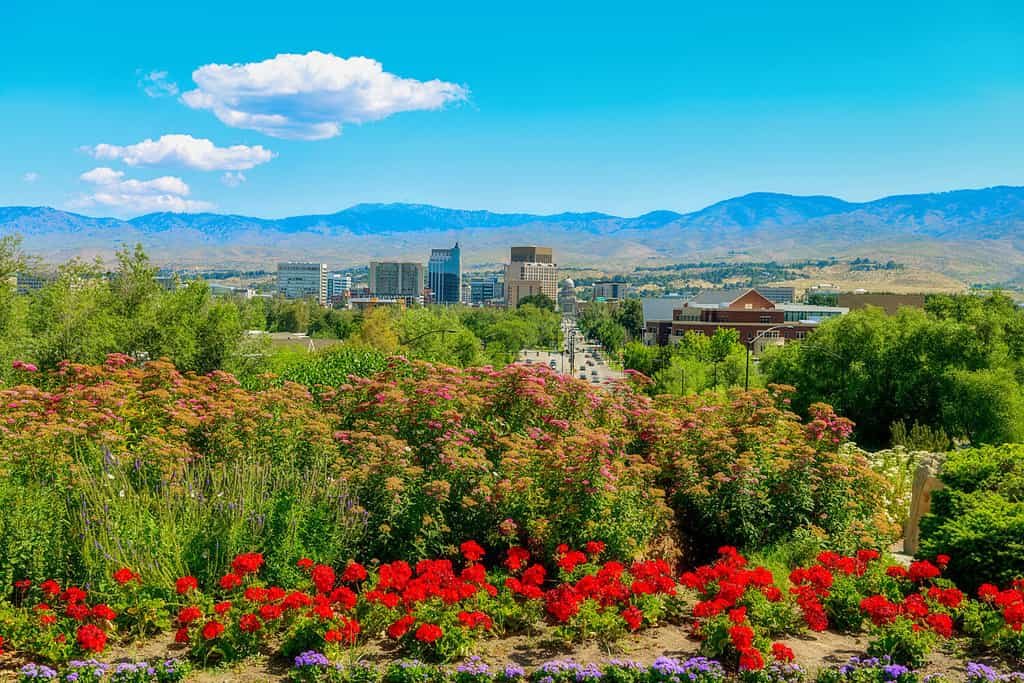
Beautiful garden filled with flowers blooming before the Boise Idaho skyline. Idaho has numerous landscapes that consist of both urban and rural areas, as well as different geographical locations and climates.
©Charles Knowles/Shutterstock.com
Geographical Landscapes in Idaho
Idaho is a land of geographical diversity, with an array of stunning landscapes that appeal to outdoor and nature lovers. From rugged mountain ranges to fertile valleys and clear lakes, the state’s varied terrain offers a wealth of recreational opportunities and natural beauty.
Mountainous Regions
Idaho is often referred to as the “Gem State,” because of the large amount of minerals and gems found there. But its mountainous regions are one of its most precious jewels. The state is home to several major mountain ranges, including the ones below:
The Rocky Mountains
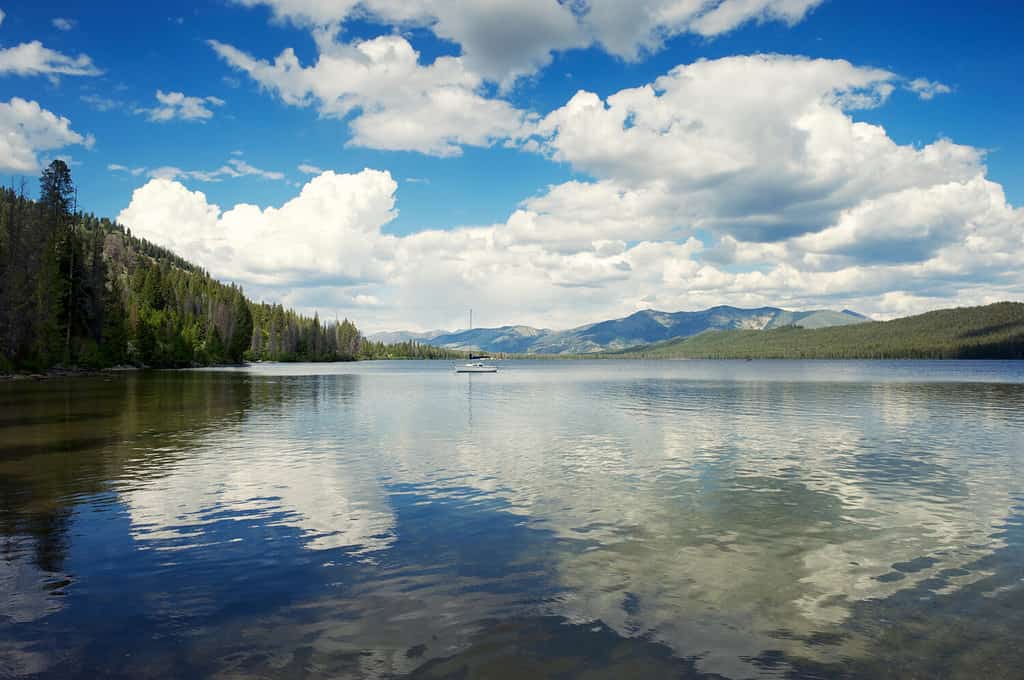
Altarus Lake is named after the former Altarus County. A panoramic view of puffy white clouds reflects on the surface of a tranquil Alturas Lake in the Rocky Mountains of Idaho, USA.
©PeskyMonkey/Shutterstock.com
The Rocky Mountains extend into the northern part of Idaho and offer gorgeous vistas, world-class skiing, and abundant outdoor activities. Iconic peaks like the Sawtooth Mountains, the Bitterroot Range, and the Selkirk Mountains are part of this vast system.
The Sawtooth Range
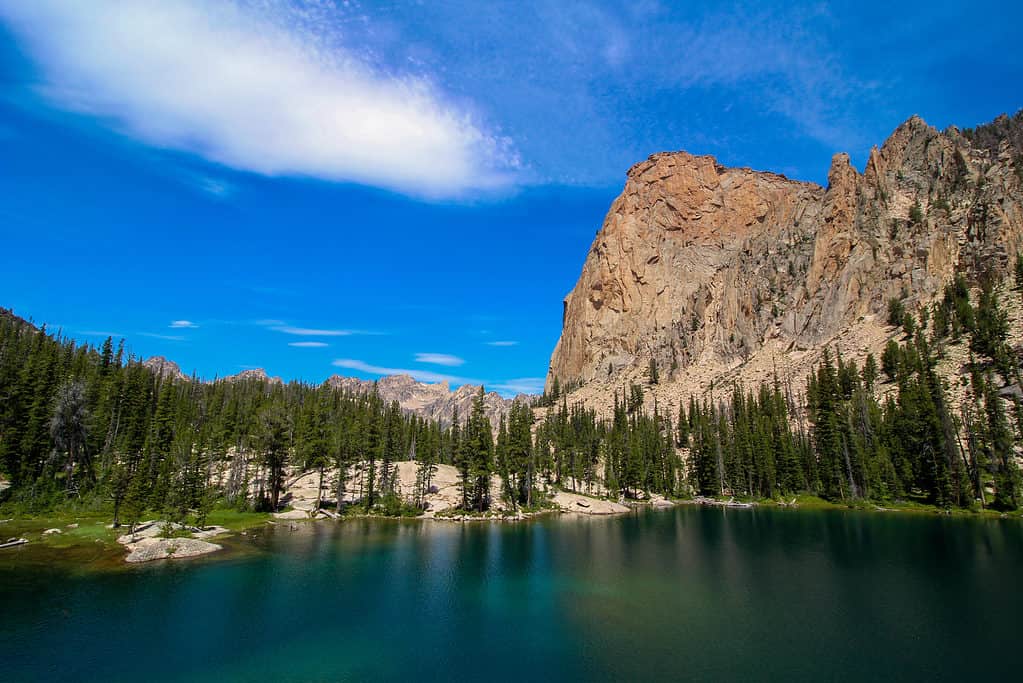
After a very intense and steep hike, you will be rewarded with an incredible view of Elephant’s Perch, above Saddleback Lake, in the Sawtooth Mountains of Idaho.
©bmswanson/Shutterstock.com
Known for its jagged peaks, crystal-clear alpine lakes, and lush wilderness, the Sawtooth Range is a crown jewel in the Idaho landscape. The Sawtooth National Recreation Area attracts hikers, campers, and outdoor enthusiasts from across the country.
The Bitterroot Mountains
Spanning the Idaho-Montana border, the Bitterroot Mountains are a remote and rugged wilderness area characterized by dense forests and towering peaks. They offer excellent opportunities for backcountry hiking and wildlife viewing.
Valleys and Plains
Amidst the mountains, Idaho has fertile valleys and plains that support agriculture.
The Snake River Plain
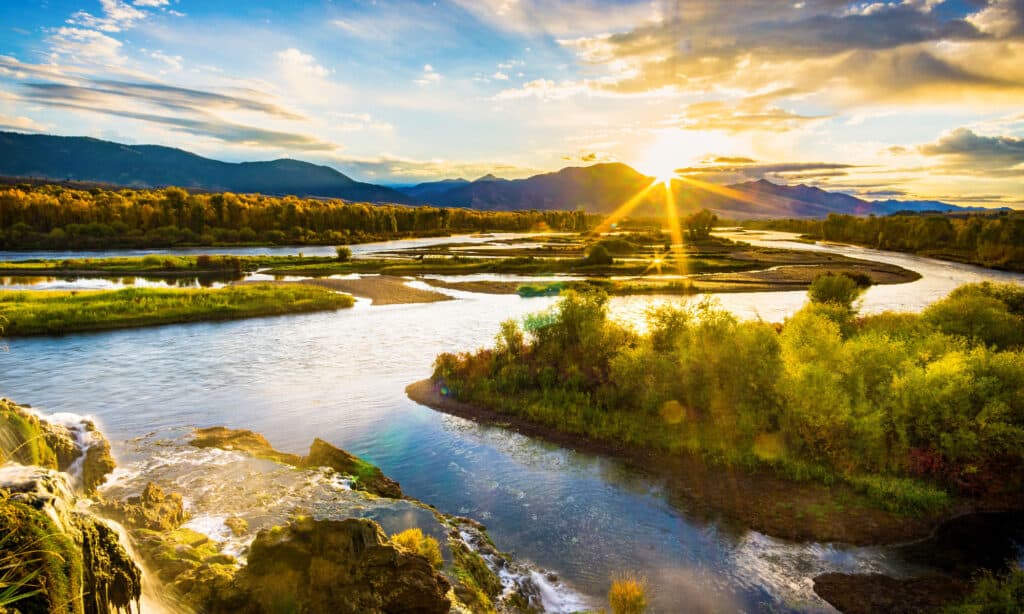
The Snake River flows through Wyoming, Idaho, Oregon, and joins the Columbia River in Washington.
©Barry Bjork/Shutterstock.com
Running through the southwestern part of the state, the Snake River Plain is a fertile agricultural region. It is also known as Treasure Valley, because of the rich fertile soil in the area. The Snake River itself carves through deep canyons and offers opportunities for boating and fishing. But this area is also one of the biggest agricultural producers in the country, especially for crops like onions, potatoes, beets and wheat as well as produce like meat and milk.
The Palouse Region
In the northwestern part of the state lies the Palouse, which is famous for its rolling hills covered in wheat fields.
3. Lakes and Waterways
Idaho has numerous lakes, rivers, and waterways that provide opportunities for water-based recreation. Lake Coeur d’Alene, in the northern part of the state, is a picturesque mountain lake known for its clear waters and scenic beauty. It is a popular destination for boating, fishing, and water sports. Located in the resort town of McCall, Payette Lake is surrounded by forests and mountains, making it a serene spot for swimming, kayaking, and paddleboarding.
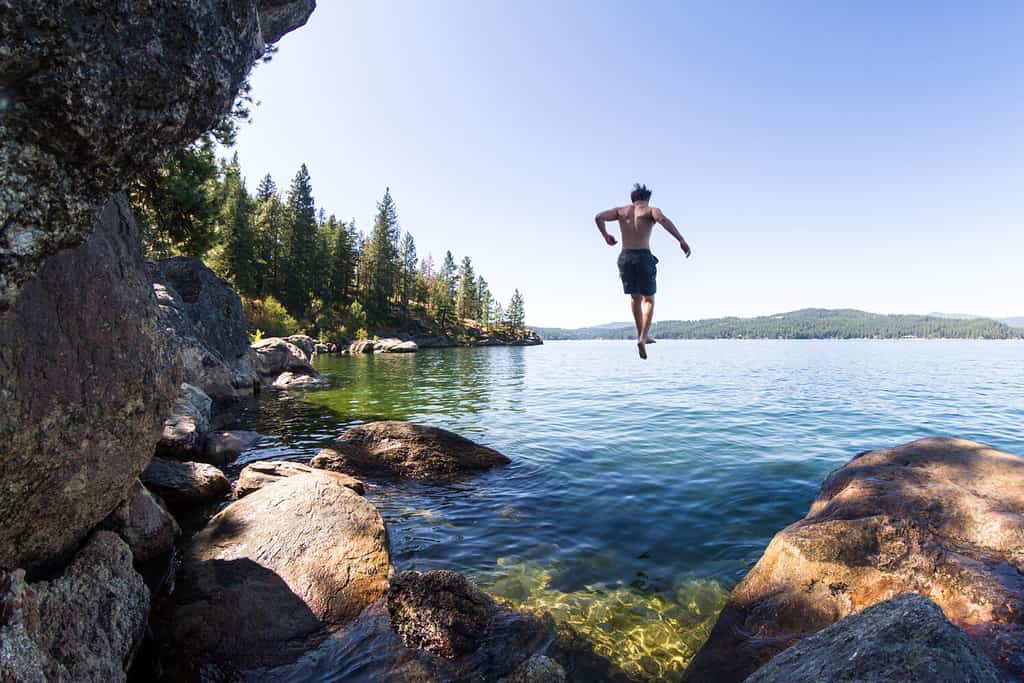
A young man jumping of a rocky cliff in Tubs Hill in to Coeur d’ Alene Lake in Northern Idaho.
©Nature’s Charm/Shutterstock.com
4. Desert Landscapes
While the state is known for its lush landscapes and wilderness, it also has some desert-like terrain. Home to the tallest freestanding sand dune in North America, Bruneau Dunes State Park offers a unique desert experience in the midst of Idaho. Visitors can hike the dunes, go sandboarding, and enjoy stargazing in the park’s observatory.
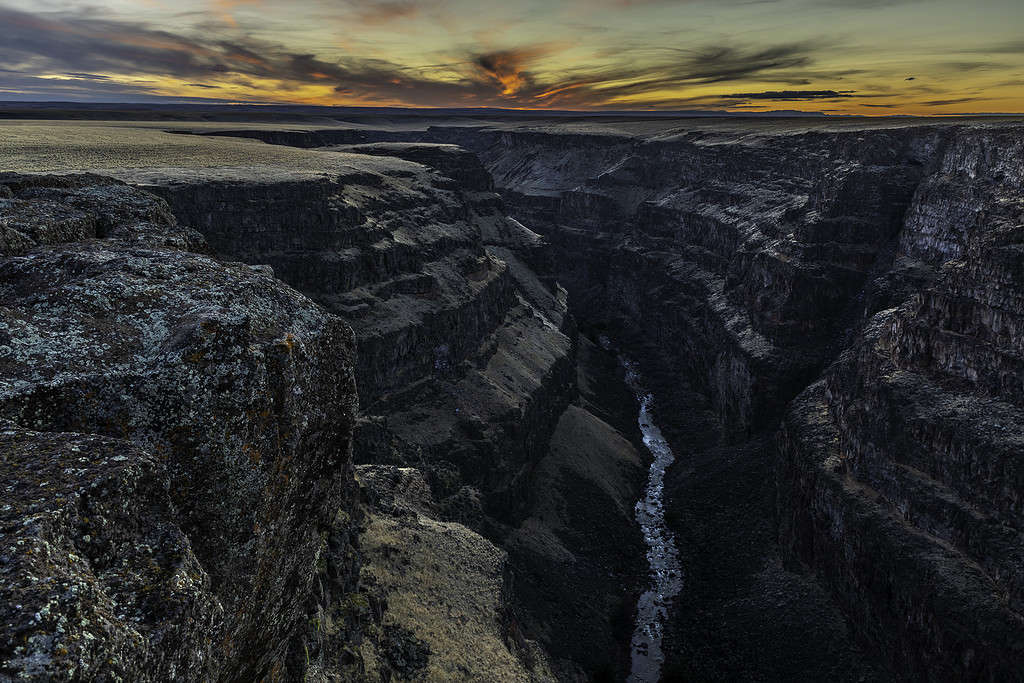
View from the top of Bruneau Canyon in Southern Idaho.
©RDavis32/ via Getty Images
5. Volcanic Landscapes
The state has a volcanic past, which has resulted in some intriguing geological features. The craters of the Moon National Monument consist of ancient lava flows, cinder cones, and caves. It is a fascinating place for hiking and exploring surreal volcanic terrain.
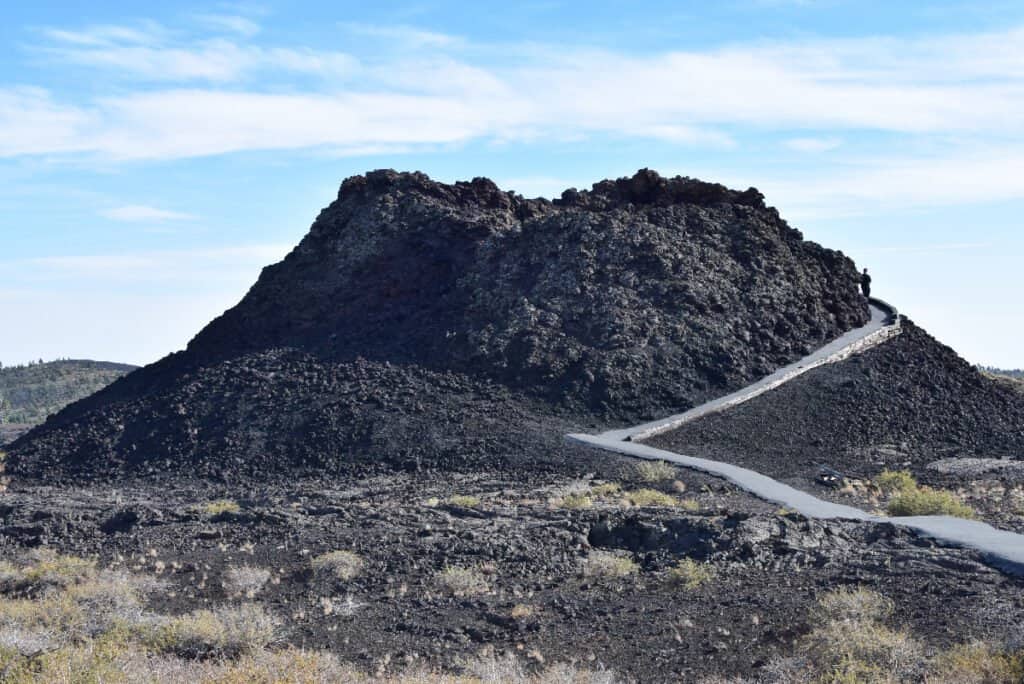
The younger volcanic activity covered the plains with basalt lava flows, including the Craters of the Moon National Monument.
©Rui Serra Maia/Shutterstock.com
6. Forest Landscapes
Forests cover a significant portion of the state’s land, providing habitat for diverse wildlife and opportunities for outdoor recreation. The Clearwater National Forest in the northern part of the state has dense evergreen forests, pristine rivers, and abundant wildlife.

The forest reflects itself in the South Fork of the Clearwater River in Idaho, USA.
©davidrh/Shutterstock.com
Wildlife in Idaho
The state’s diverse landscapes, including its mountains, forests, rivers, and plains, create a rich and varied habitat for a wide range of wildlife species.
Mammals
The state is home to an impressive variety of mammals, from small rodents to large predators. Some notable species including moose, elk, white-tailed deer, mule deer, grizzly bears, black bears, gray wolves, mountain lions, bighorn sheep, coyotes, foxes and bobcats. Moose are iconic in the state, often seen in the northern and central regions, especially in areas like the Selkirk and Bitterroot Mountains.

Black bears in Idaho prefer mixed deciduous-coniferous forests. They however occupy and use wet meadows, riparian areas, and subalpine ridgetops.
©iStock.com/christiannafzger
The state also has one of the largest elk populations in the United States. They are present in the mountainous regions, including the Sawtooth National Recreation Area. Both white-tailed and mule deer are common throughout Idaho. While grizzly bears are rare in the state and primarily found in the remote wilderness areas, black bears are more common and inhabit forests and mountainous regions.
The state also has a thriving gray wolf population, especially in the central and northern parts of the state. Mountain lions are elusive but inhabit the state’s wilderness areas, including the Clearwater National Forest. Idaho’s rugged mountain terrain provides an ideal habitat for bighorn sheep, with populations found in areas like Hells Canyon. These smaller predators are widespread across the state’s varied landscapes.
Birds
Idaho is a birdwatcher’s paradise, with numerous species of birds roaming around its skies and forests. Bald eagles are often present near rivers and lakes, such as Lake Coeur d’Alene and the Snake River. These remarkable birds of prey also roam Idaho’s cliffs and canyons. Sandhill cranes are common in wetland areas, and the Camas National Wildlife Refuge is a prime spot for viewing them. Various species of hawks, owls, and kestrels are present throughout the state, particularly in its open spaces.
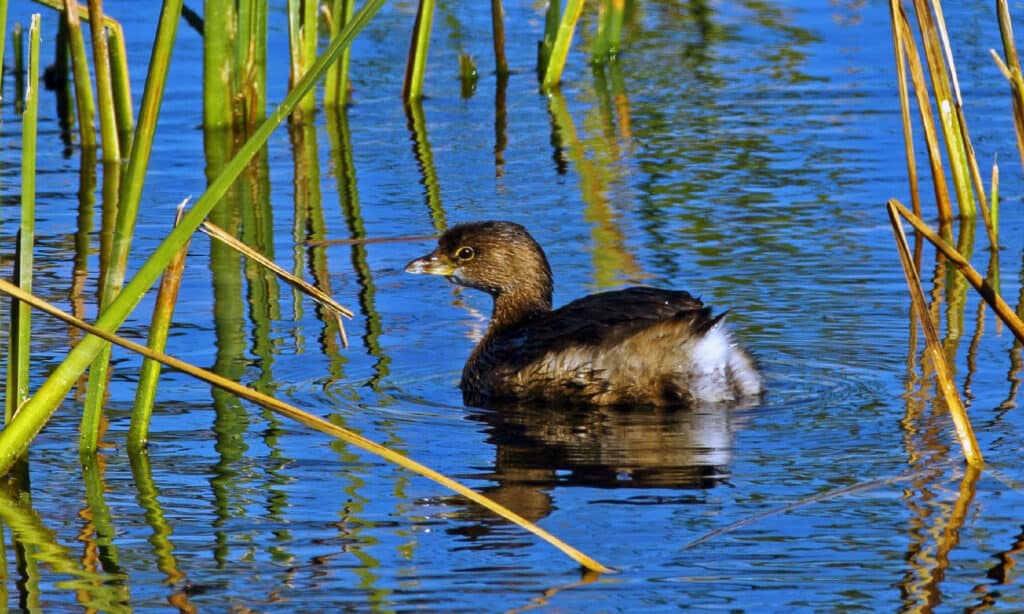
Market Lake comes alive in the spring each year with many species of birds including the pied-billed grebe.
©iStock.com/photographybyJHWilliams
3. Fish
Idaho is famous for its pristine rivers and lakes, which support a diverse population of fish. The state is famous for its native cutthroat trout, including the Yellowstone cutthroat, which is found in the state’s mountain streams.
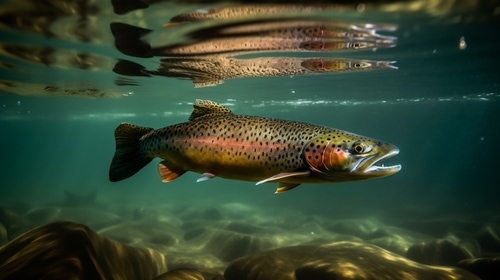
Rainbow trout swimming in natural underwater habitat, shallow depth of field.
©Henrik A. Jonsson/Shutterstock.com
Rainbow Trout and Brown Trout are popular sportfish are abundant in many of the state’s rivers and lakes. Idaho’s rivers, including the Salmon River, are critical spawning habitats for the steelhead and chinook salmon fish.
4. Amphibians and Reptiles
Idaho is home to a variety of amphibians and reptiles, including frogs, toads, salamanders, rattlesnakes, and garter snakes.
5. Insects and Invertebrates
The state’s diverse ecosystems also support a wide range of insects and invertebrates, many of which play vital roles in pollination and ecosystem health.

Conservation Efforts
Idaho recognizes the importance of preserving its rich biodiversity. The state has established numerous wildlife refuges, conservation areas, and wilderness zones to protect and conserve its natural treasures. Organizations, such as the Idaho Department of Fish and Game and various non-profits, work tirelessly to monitor and protect the state’s wildlife populations.
Idaho’s wildlife is a testament to the state’s natural beauty and ecological richness. From its majestic mammals to its vibrant birdlife and thriving fish populations, the diverse landscapes of Idaho offer valuable opportunities for conservation and research. Whether you’re exploring the backcountry of the Sawtooth Mountains or birdwatching along the Snake River, Idaho’s wildlife is a source of wonder and inspiration for all.
Final Thoughts
Idaho is a state of remarkable size and diversity. It offers a wide range of landscapes, from rugged mountains to fertile plains, making it a captivating destination for nature lovers and adventurers. While it may not be the largest state in the U.S., Idaho’s size is undeniably impressive, providing ample room for all of its lovely natural wonders.
Thank you for reading! Have some feedback for us? Contact the AZ Animals editorial team.

